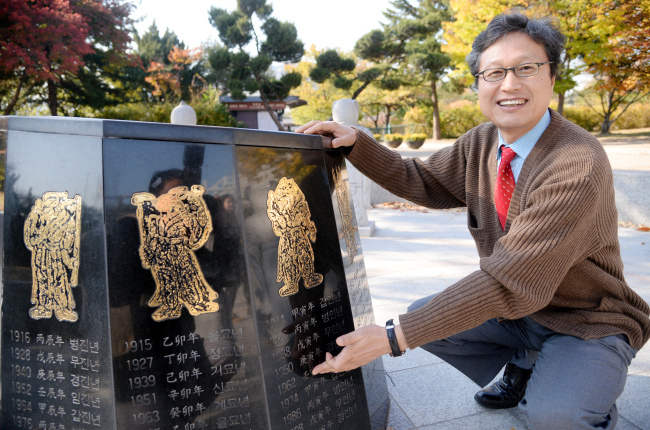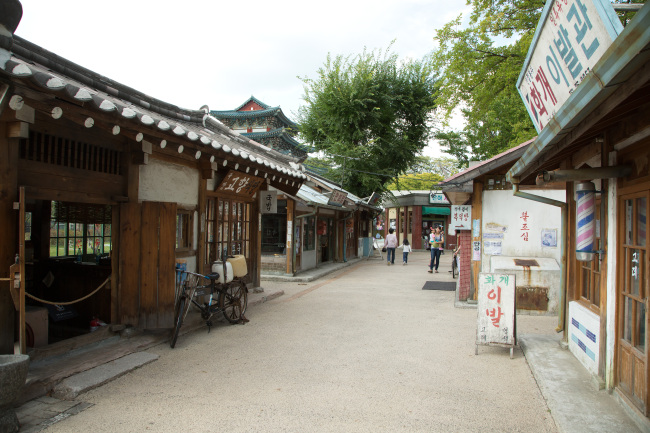Rest, childbirth and blue jeans.
These are some of the themes of exhibitions held by the National Folk Museum of Korea since last year.
Some of these special, but not-so-special topics raised eyebrows, but Cheon Jin-gi, the director of the state-run museum, touts that they fit perfectly with the vision he has for the museum.
“Those topics cut across generations and cultural boundaries,” he explained at his office on a recent Tuesday afternoon. “They are good materials to help people understand the universality and peculiarity of their culture.”
Unlike other state-run museums that pay a great deal of attention to ancient history, the folk museum focuses on the daily life of ordinary people from the relatively recent past till now, he said.
“We don’t display some isolated relics from the ancient past. We showcase things from the recent past that many visitors still have a personal memory of.”
 |
| Cheon Jin-gi, director of the National Folk Museum of Korea, explains how the 12 zodiac animals are used at the museum’s frontyard in Seoul. (Park Hyun-koo/The Korea Herald) |
He cited the ongoing exhibition on blue jeans to explain how the museum takes a different approach from other museums.
If a family of three generations comes to see the show, which explores how the garment moved from being work clothes for Californian miners to part of the Korean wardrobe, he said, each and every member will have something to say about the theme.
“Foreigners, too. They will realize that they have their own stories to tell,” he added.
That way, a museum becomes more than a place for knowledge. It provides visitors an opportunity to look back on their own personal history and better understand their present life, he stressed.
Since opening in early October, the “Blue Jeans” exhibit has drawn feedback from visitors. Some wanted to share their story about denim or donate their personal collections.
“We will revamp parts of the exhibit soon, reflecting the feedback,” the director said.
Cheon, 52, has been leading the museum as director since 2011. Prior to that, he was a curator specializing in animal folklore.
“For me, the goal has always been and still is to make exhibitions come alive.”
“By alive, I mean interactive and fun-filled,” he added.
In Korea, museums are not often associated with fun.
“Many say they come to a museum to study. I want to change that. I want people to come to my museum to eat or to have fun,” he said.
Nestled on the grounds of Gyeongbokgung Palace and within walking distance of Insa-dong and Samcheong-dong, Seoul’s must-see districts for tourists, the folk museum is already one of the most visited in Korea.
It gets around 2.3 million visitors a year, which is the second-largest number after the National Museum of Korea. Of the total, slightly more than 50 percent are foreigners.
 |
| “A Street to the Past,” an outdoor exhibit that features retro street shops, transports visitors back to ’60s and ’70s Korea. (National Folk Museum of Korea) |
“This, of course, can mainly be attributed to the location,” he admitted.
But he wants to believe that the series of efforts by the museum staff to make the museum more accessible and inviting has also played a part.
Recording and preserving the folk culture of Korea now is another task of the museum.
“In this mass-production, mass-consumption economy, what do we need to preserve for the future generations? It’s not an easy question,” he confessed.
Since 2006, the museum has been conducting a series of so-called household surveys, through which researchers record everything that the selected family owns and uses.
“In the case of major national events, our researchers are dispatched to make a record of them and collect whatever is deemed to be of worth,” Cheon said.
Among the items collected that way is a giant national flag used for cheering for the Korean team in the 2002 FIFA World Cup, jointly held in Korea and Japan.
“It’s huge, measuring 40 meters by 60 meters. Without it, we would have only photos and video clips through which we can remember the 2002 (event),” he said.
Backed by enthusiastic cheering by compatriots, the Korean team had a miraculous run in the soccer tournament, reaching the semifinals.
An authority on the 12 zodiac animals, the director frequently appears on TV and in the print media when the New Year approaches.
“You may brush aside the animal signs as superstitions, but they still have some impact on state affairs,” he said, pointing out the hike in the country’s birthrate in 2007, considered auspicious as it was the year of the golden pig.
“Many people still buy lottery tickets after seeing a pig in their dream, because a pig is associated with wealth.”
Next year will be the year of the sheep, a docile animal which signifies harmony and calmness, he said.
By Lee Sun-young (milaya@heraldcorp.com)



